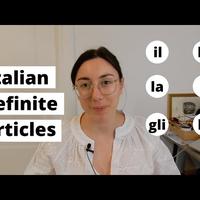Let's review Italian definite articles (il, lo, la, i, gli, le) (for all levels)
||||the|||||||||levels
Let's review Italian definite articles (il, lo, la, i, gli, le) (for all levels)
Repasemos los artículos definidos italianos (il, lo, la, i, gli, le) (para todos los niveles)
Ciao a tutti e bentornati sul mio canale.
Nel video di oggi vorrei fare un ripasso degli articoli determinativi per chiarire alcune cose.
In today's video I would like to review the definite articles to clarify some things.
Se avete bisogno dei sottotitoli, mi raccomando, attivateli.
|||||||activate them
If you need subtitles, please turn them on.
Questi che vedete sullo schermo sono gli articoli determinativi: il, i, lo, gli, la, le.
These you see on the screen are the definite articles: il, i, lo, gli, la, le.
Iniziamo dagli articoli maschili.
Let's start with masculine articles.
Abbiamo due opzioni per il maschile: il, lo.
We have two options: il, lo.
Cominciamo da "lo", che possiamo trovare anche nella versione L',
Let's start with "lo", which we can also find in the L' version,
si usa con i nomi maschili che iniziano con una vocale, con S + consonante, ps, gn, x, y, z.
it is used with masculine nouns starting with a vowel, with S + consonant, ps, gn, x, y, z.
Il plurale è "gli".
The plural form is "gli".
L'altra opzione che abbiamo è l'articolo "il" che invece si usa con tutti gli altri nomi maschili che iniziano con una consonante;
The other option we have is the article "il" which is used with all other masculine nouns starting with a consonant;
il plurale è "i".
the plural is "i".
Vediamo alcuni esempi.
Let's see some examples.
La parola "tavolo" è maschile, inizia con la consonante t,
The word "table" is masculine, it starts with the consonant t,
perciò dobbiamo usare l'articolo "il".
so we have to use the article "il".
Il tavolo.
The table.
Al plurale, i tavoli.
In the plural, the tables.
La parola "quaderno" inizia con la consonante q, quindi usiamo l'articolo "il".
The word "quaderno" starts with the consonant q, so we use the article "il".
Il quaderno.
The notebook.
Al plurale, i quaderni.
In the plural, the notebooks.
Vediamo ora un paio di esempi con l'articolo "lo".
Let's now look at a couple of examples with the article "lo".
Ad esempio, la parola "stivale" inizia con S + consonante, perciò vuole l'articolo "lo".
For example, the word "stivale" starts with S + consonant, so it wants the article "lo".
Lo stivale.
The boot.
Al plurale, gli stivali.
In the plural, boots.
Vediamo ora la parola "albero".
Let's now see the word "albero".
È una parola maschile che inizia con una vocale, perciò vuole l'articolo "lo".
It's a masculine word that starts with a vowel, so it wants the article "lo".
Qui però ci sono due vocali una dopo l'altra, una che segue l'altra,
Here, however, there are two vowels one after the other, one following the other,
perciò in questo caso dobbiamo fare quella che si chiama "elisione" della vocale dell'articolo.
||||||||||elision|||
so in this case we have to do what is called "elision" of the vowel in the article.
Perciò "lo albero" diventa "l'albero".
Therefore "lo albero" becomes "l'albero".
Al plurale, gli alberi.
In the plural, trees.
Parlando con voi nei commenti qui su YouTube, ma anche su Instagram,
Speaking with you in the comments here on YouTube, but also on Instagram,
mi sono resa conto che la consuetudine è insegnare che L' è un articolo indipendente, quando in realtà non lo è.
I realized that the custom is to teach that L' is an independent article, when in fact it is not.
Quando vedete l'apostrofo si tratta semplicemente del risultato dell'elisione della vocale nell'articolo LO oppure nell'articolo LA.
||||||||the elision|||||||
When you see the apostrophe it is simply the result of the elision of the vowel in the article LO or in the article A.
Che cos'è l'elisione?
What is elision?
L'elisione è il fenomeno per cui si toglie la vocale - in questo caso dell'articolo LO o dell'articolo LA -
Elision is the phenomenon whereby the vowel is removed - in this case from the article LO or the article LA -
quando il sostantivo che segue inizia con un'altra vocale.
when the noun that follows begins with another vowel.
L''elisione si segnala con un apostrofo.
elision|||||
The elision is indicated with an apostrophe.
Io sinceramente trovo strano che venga insegnato che L' è un articolo indipendente.
I honestly find it odd that it is taught that L' is an independent article.
Alcuni dicono che si fa per facilitare la spiegazione.
Some say it is done to facilitate explanation.
Sono d'accordo in parte, perché comunque ci sono dei limiti.
I agree in part, because there are limits anyway.
Perché nel caso in cui dobbiamo usare dei nomi che iniziano con vocale,
In case we have to use nouns that start with a vowel,
ma che finiscono in -e (quindi invariabili dal punto di vista del genere),
but end in -e (therefore invariable from the point of view of gender),
dobbiamo sapere se, per esempio, stiamo parlando di "lo insegnante" oppure "la insegnante",
we need to know if, for example, we are talking about "a male teacher" or "a female teacher" ,
soprattutto se poi dobbiamo accordare l'aggettivo che segue.
especially if we then have to agree the adjective that follows.
Quindi se si insegna che con un sostantivo come per esempio "insegnante",
So if you teach that with a noun such as "teacher",
che inizia con una vocale, si usa l'articolo L' e la spiegazione finisce lì,
starting with a vowel, you use the article L' and the explanation ends there,
c'è, a mio avviso, una grossa mancanza di informazioni.
there is, in my opinion, a great lack of information.
Perché come fa uno studente ad accordare gli aggettivi che potrebbero seguire (senza sapere se il sostantivo è maschile o femminile)?
Because how does a student know how to agree the adjectives that might follow (without knowing if the noun is masculine or feminine)?
Io sono più per la spiegazione del fenomeno dell'elisione subito, a qualsiasi livello,
I am more for the explanation of the phenomenon of elision early on at any level,
perché se una cosa viene spiegata bene, gli studenti la capiscono.
because if something is explained well, students will understand it.
E non è una cosa così difficile da evitare di spiegarla.
And it's not that hard to avoid explaining it completely.
Trovo un po' controproducente questo ragionamento,
I find this reasoning a bit counterproductive,
perché adesso forse facilitiamo le spiegazioni, ma poi questo problema ritornerà più avanti,
|||facilitate|||||||||
because we now might facilitate explanations, but then this problem will come back around later,
quando gli studenti si rendono conto di come funziona la lingua o perché magari sono a un livello più alto e non capiscono come fare l'accordo.
when students realize how language works or because maybe they are at a higher level and do not understand how to do the noun-adjective agreement.
Quindi, secondo me, è meglio spiegare tutto chiaramente fin dall'inizio,
So, in my opinion, it is best to explain everything clearly from the beginning,
soprattutto perché gli articoli determinativi sono una parte fondamentale della lingua.
especially since definite articles are a fundamental part of the language.
Li utilizziamo costantemente.
We use them constantly.
Vediamo ora gli articoli femminili.
Let's now look at the feminine articles.
Al singolare abbiamo "la", che possiamo trovare anche nella versione L'.
In the singular we have "la", which we can also find in the L' version.
LA si usa con tutti i sostantivi femminili.
LA is used with all feminine nouns.
Se i sostantivi femminili iniziano con una vocale, allora LA diventa L', ma stiamo parlando dello stesso articolo.
If feminine nouns start with a vowel, then LA becomes L', but we are talking about the same article.
Al plurale è "le".
The plural form it is "le". Let's see some examples.
Vediamo alcuni esempi.
La parola "scala".
The word "scala".
La scala.
The ladder.
L'échelle.
Al plurale, le scale.
In the plural, the ladders/stairs.
La parola "ape" inizia con una vocale,
The word "ape" starts with a vowel,
Le mot "abeille" commence par une voyelle,
quindi "la ape" diventa "l'ape", perché ci sono due vocali che si susseguono.
so "la ape" becomes "l'ape", because there are two vowels that follow each other.
Al plurale, le api.
In the plural, bees.
Nella descrizione della lezione qui sotto vi lascerò alcuni link con degli esercizi,
In the description of the lesson below I will leave some links with exercises,
se volete esercitarvi con gli articoli determinativi.
if you want to practice with the definite articles.
Io vi ringrazio per aver guardato questa lezione.
I thank you for watching this lesson.
Se avete delle domande, lasciate nei commenti qui sotto.
If you have any questions, leave them in the comments below.
E noi ci vediamo nella prossima lezione.
And I'll see you in the next lesson.
A presto, ciao!
See you soon, bye!

